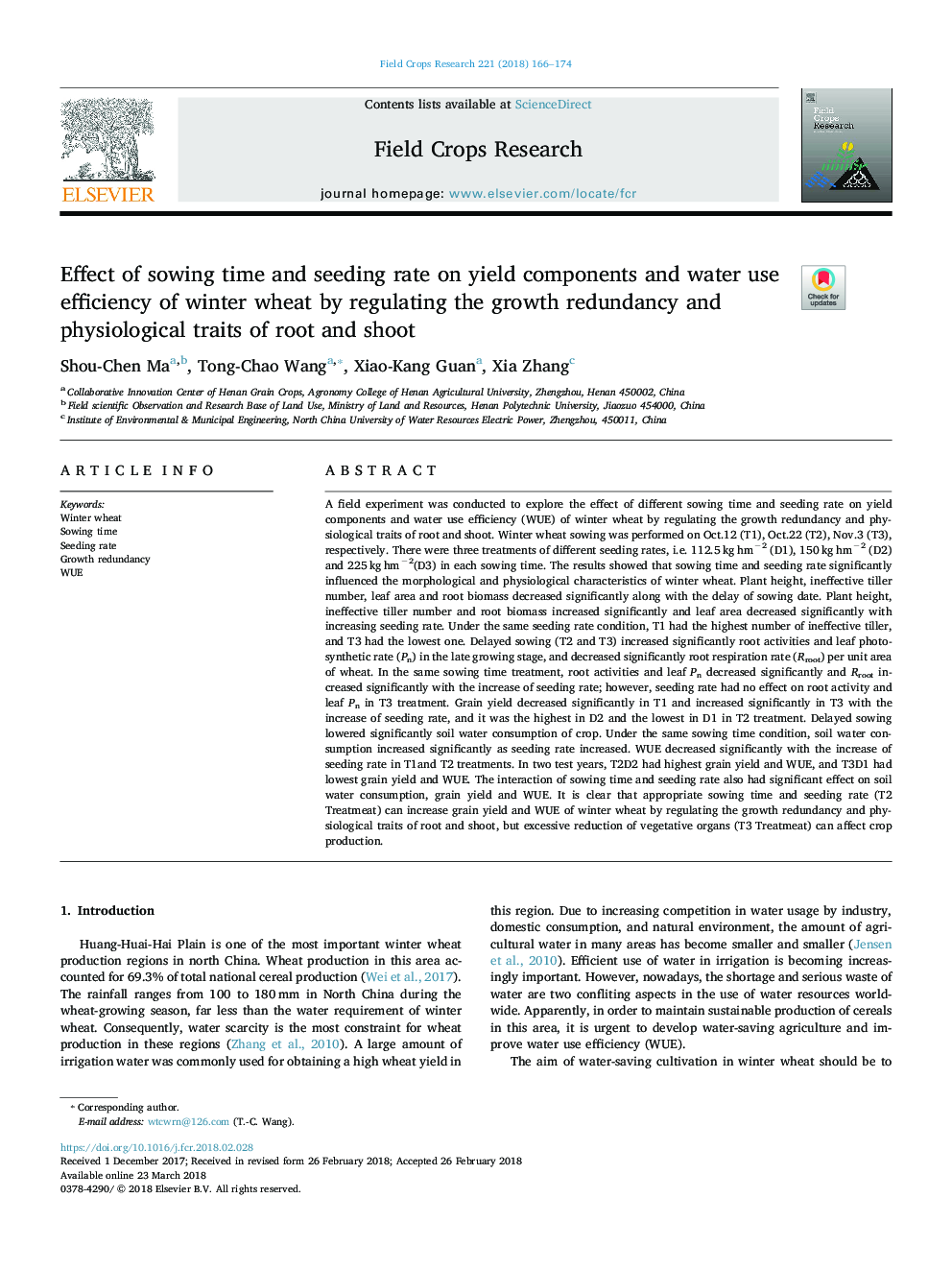| کد مقاله | کد نشریه | سال انتشار | مقاله انگلیسی | نسخه تمام متن |
|---|---|---|---|---|
| 8879245 | 1624642 | 2018 | 9 صفحه PDF | دانلود رایگان |
عنوان انگلیسی مقاله ISI
Effect of sowing time and seeding rate on yield components and water use efficiency of winter wheat by regulating the growth redundancy and physiological traits of root and shoot
ترجمه فارسی عنوان
اثر زمان کاشت و میزان جوانه زنی بر اجزای عملکرد و بهره وری مصرف آب گندم زمستانه با تنظیم تعدیل رشد و صفات فیزیولوژیکی ریشه و
دانلود مقاله + سفارش ترجمه
دانلود مقاله ISI انگلیسی
رایگان برای ایرانیان
موضوعات مرتبط
علوم زیستی و بیوفناوری
علوم کشاورزی و بیولوژیک
علوم زراعت و اصلاح نباتات
چکیده انگلیسی
A field experiment was conducted to explore the effect of different sowing time and seeding rate on yield components and water use efficiency (WUE) of winter wheat by regulating the growth redundancy and physiological traits of root and shoot. Winter wheat sowing was performed on Oct.12 (T1), Oct.22 (T2), Nov.3 (T3), respectively. There were three treatments of different seeding rates, i.e. 112.5â¯kgâ¯hmâ2 (D1), 150â¯kgâ¯hmâ2 (D2) and 225â¯kgâ¯hmâ2(D3) in each sowing time. The results showed that sowing time and seeding rate significantly influenced the morphological and physiological characteristics of winter wheat. Plant height, ineffective tiller number, leaf area and root biomass decreased significantly along with the delay of sowing date. Plant height, ineffective tiller number and root biomass increased significantly and leaf area decreased significantly with increasing seeding rate. Under the same seeding rate condition, T1 had the highest number of ineffective tiller, and T3 had the lowest one. Delayed sowing (T2 and T3) increased significantly root activities and leaf photosynthetic rate (Pn) in the late growing stage, and decreased significantly root respiration rate (Rroot) per unit area of wheat. In the same sowing time treatment, root activities and leaf Pn decreased significantly and Rroot increased significantly with the increase of seeding rate; however, seeding rate had no effect on root activity and leaf Pn in T3 treatment. Grain yield decreased significantly in T1 and increased significantly in T3 with the increase of seeding rate, and it was the highest in D2 and the lowest in D1 in T2 treatment. Delayed sowing lowered significantly soil water consumption of crop. Under the same sowing time condition, soil water consumption increased significantly as seeding rate increased. WUE decreased significantly with the increase of seeding rate in T1and T2 treatments. In two test years, T2D2 had highest grain yield and WUE, and T3D1 had lowest grain yield and WUE. The interaction of sowing time and seeding rate also had significant effect on soil water consumption, grain yield and WUE. It is clear that appropriate sowing time and seeding rate (T2 Treatmeat) can increase grain yield and WUE of winter wheat by regulating the growth redundancy and physiological traits of root and shoot, but excessive reduction of vegetative organs (T3 Treatmeat) can affect crop production.
ناشر
Database: Elsevier - ScienceDirect (ساینس دایرکت)
Journal: Field Crops Research - Volume 221, 15 May 2018, Pages 166-174
Journal: Field Crops Research - Volume 221, 15 May 2018, Pages 166-174
نویسندگان
Shou-Chen Ma, Tong-Chao Wang, Xiao-Kang Guan, Xia Zhang,
